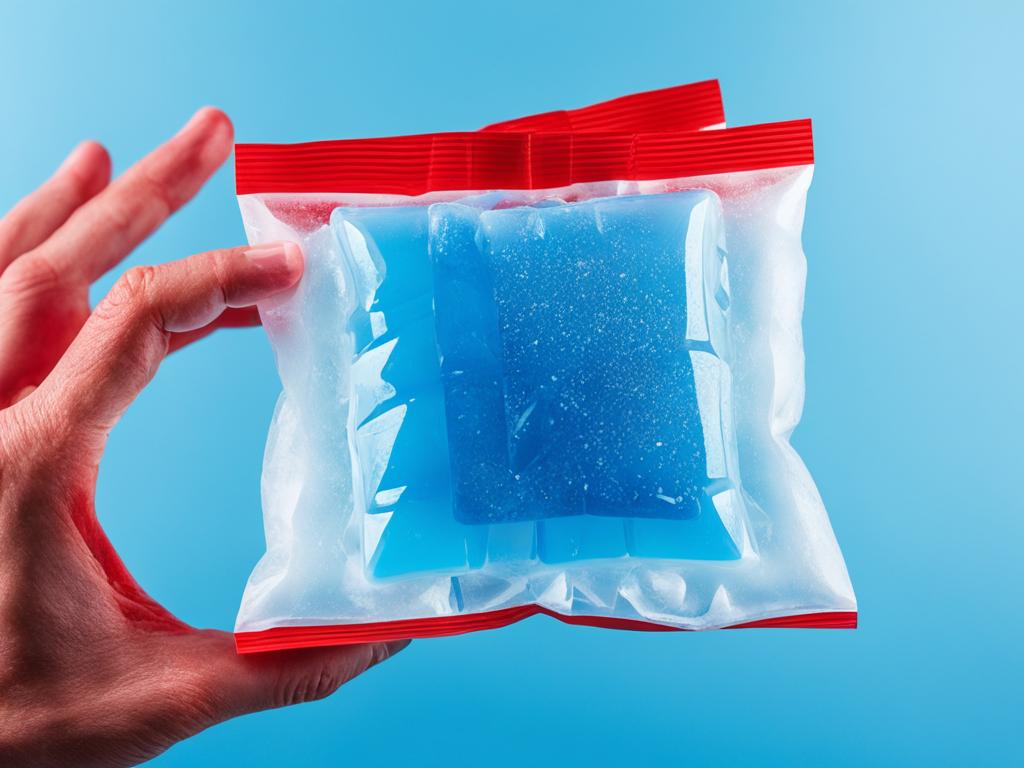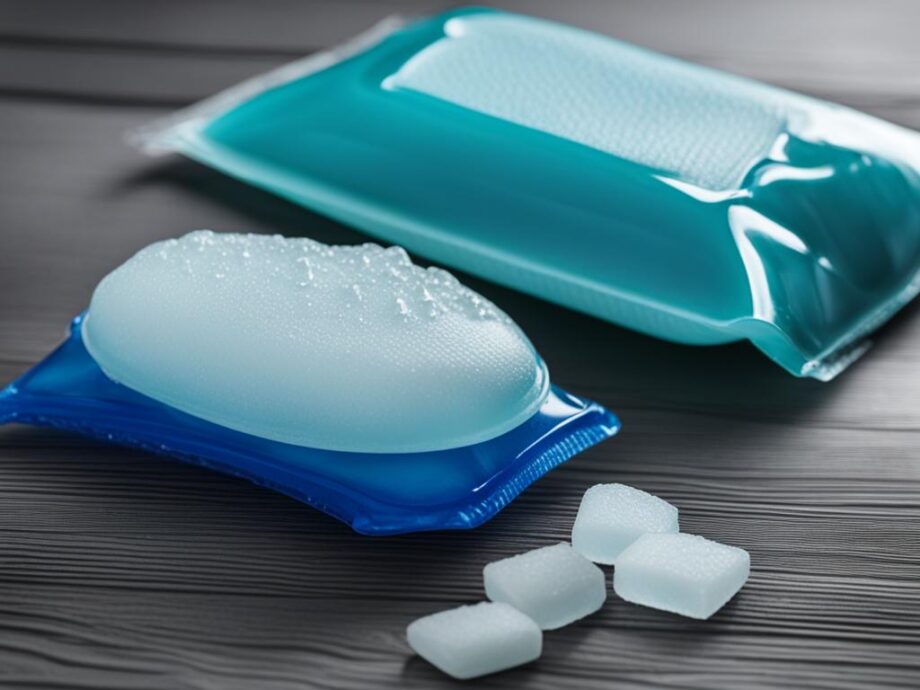When it comes to treating pain and injuries, there are various therapy options available, but gel packs and ice packs remain the most popular choices. Both therapies offer different benefits and uses, making it essential to understand them to choose the most suitable option for your specific needs.
In this article, we will compare gel pack vs ice pack and determine the best choice for pain relief. We will explore the benefits and uses of both therapy options and discuss how they can provide effective relief for injuries and discomfort. So, let’s dive in and learn more about gel packs and ice packs.
Key Takeaways
- Gel packs and ice packs are popular therapy options for pain relief and injury treatment.
- Gel packs are filled with a gel-like substance and can retain temperature for longer periods.
- Ice packs are typically filled with ice or a gel that can be frozen and provide immediate cold therapy.
- The choice between gel packs and ice packs depends on the nature of the injury or discomfort.
- Gel packs are recommended for long-term therapy, while ice packs are ideal for reducing swelling and numbing acute pain.
Understanding Gel Packs
Gel packs have gained popularity over the years as a convenient pain relief option. These handy packs contain a gel-like substance that can be refrigerated or heated in the microwave to provide relief for various ailments. Gel packs offer numerous benefits, including:
- Pain relief: Gel packs can be used to alleviate pain caused by injuries, muscle soreness, and chronic conditions.
- Reduced inflammation: Gel packs can reduce inflammation and swelling for quicker recovery.
- Convenience: Gel packs are easy to use and can be carried around for on-the-go pain relief.
- Custom fit: Gel packs conform to your body’s contours, allowing for better coverage and contact for more effective therapy.
People use gel packs for a variety of purposes, such as reducing a headache, soothing menstrual cramps, or aiding post-workout recovery. They are also a popular option for managing pain caused by injuries or long-term conditions like arthritis. Gel packs are versatile, making them a valuable addition to your home health kit.
“Gel packs are applied topically and can provide relief for a variety of pains and injuries.” – Dr. Maria Brown
Using Gel Packs for Pain Relief
Gel packs can be used for a variety of pain relief purposes. For acute injuries, applying a cold gel pack can help reduce swelling and numbing pain. In contrast, warm gel packs are used to increase blood flow and relaxation in the muscles, making them a great option for chronic conditions or muscle stiffness. Regardless of the type of gel pack used, they are effective for pain relief and can reduce recovery time by promoting faster healing.
The Science Behind Gel Pack Therapy
Gel packs work by absorbing and retaining heat or cold for therapeutic relief. When frozen, gel packs can provide cold therapy to a specific body part to reduce inflammation, swelling, and pain. During heat therapy, blood vessels dilate in the affected area, promoting increased blood flow and faster healing.

Gel packs are a safe and effective therapy option for relieving pain. Whether you’re recovering from an injury or managing chronic pain, gel packs can provide relief and aid in the healing process.
Exploring Ice Packs
Ice packs are an effective therapy option for reducing swelling and numbing pain. These packs are typically filled with ice or a gel that can be frozen, providing cold therapy to the affected area. Ice packs are commonly used for acute injuries, such as sprains, strains, or bruises, as they help constrict blood vessels and reduce inflammation.
One of the main benefits of ice pack therapy is its ability to provide immediate relief for acute pain. The cold temperature can help numb the area and alleviate discomfort, making it a popular choice for sports injuries or sudden accidents. Additionally, ice packs can help reduce swelling by constricting blood vessels, limiting the flow of fluids to the affected area.
Ice packs can be easily found at drugstores or grocery stores, and they are relatively inexpensive. They can be kept in the freezer for long-term use, making them a convenient and accessible therapy option.
Overall, ice pack therapy can be an effective solution for acute injuries and pain relief. When used in conjunction with other therapies, such as rest, compression, and elevation, ice packs can aid in faster recovery and reduce the risk of long-term complications.

Gel Pack vs Ice Pack for Pain Relief
When it comes to pain relief, gel packs and ice packs are popular choices, but their differences should be taken into consideration before making a choice. Gel packs are known for their ability to retain temperature for longer periods, making them ideal for extended therapy sessions. They offer better flexibility and adapt to the body’s contours, providing better contact and coverage. On the other hand, ice packs offer an immediate cold sensation, which is often favored for acute injuries with significant swelling.
| Gel Pack | Ice Pack | |
|---|---|---|
| Benefits | Retains temperature for longer periods | Offers immediate and intense cold sensations |
| Uses | Reduces inflammation Soothes muscle soreness Alleviates pain caused by chronic conditions |
Reduces swelling Numbs acute pain Recommended for acute injuries such as sprains, strains, or bruises |
| Recommended for | Chronic conditions or injuries requiring longer-term therapy | Acute injuries where immediate pain relief and reduction in swelling are crucial |
| Overall | Provides sustained therapy and better flexibility | Offers immediate cold therapy and helps reduce swelling |
Both gel packs and ice packs can help provide pain relief, but choosing the right therapy should be based on the nature and severity of the injury or discomfort. Gel packs are recommended for longer-term therapy, whereas ice packs are more suitable for acute injuries because they provide immediate relief to pain and swelling.
Gel Pack vs Ice Pack for Injuries
When it comes to treating injuries, both gel packs and ice packs can provide effective relief for discomfort and promote healing. However, the specific therapy option that’s better suited for your injury will depend on your unique circumstances.
Gel packs are commonly used for chronic conditions or injuries that require longer-term therapy. The gel inside the packs is designed to retain temperature, providing continuous relief, and aiding in the healing process. Gel packs are excellent for conditions such as arthritis or tendonitis, where consistent therapy is required.
On the other hand, ice packs are ideal for acute injuries, where the immediate pain relief and reduction in swelling are crucial. Ice packs are often used for joint sprains, muscle strains, and bruises. The cold temperature constricts blood vessels, reducing blood flow and swelling, alleviating pain, and promoting healing.
It’s worth noting that overusing either therapy option can have adverse effects. For example, applying an ice pack to your skin for too long can cause frostbite or skin damage. Similarly, warm gel packs shouldn’t be used for too long as it can cause burns or skin irritation. Always follow the instructions provided with your therapy pack and consult a healthcare professional before starting any new treatment.
An ideal therapy regimen may involve a combination of both gel and ice packs, depending on the nature and severity of your injury. Consult with a healthcare professional for personalized recommendations on the best therapy option for your specific injury or condition.

Using a combination of gel packs and ice packs and following the proper therapy guidelines, you can alleviate discomfort and aid in your healing process effectively.
Gel Pack and Ice Pack Therapy Uses
Besides providing pain relief, gel packs and ice packs have versatile therapy uses that can aid in the healing process. Determining which type of therapy is best suited for your specific needs can help you maximize their benefits and achieve optimal results.
Gel Pack Uses
Gel pack uses are numerous and diverse. Here are some of the most common applications:
| Type of Use | Description |
|---|---|
| Headache relief | Gel packs can help reduce tension headaches and migraines by providing a cooling effect to the forehead or temple. |
| Menstrual cramp relief | Gel packs can soothe menstrual cramps by delivering a gentle and sustained cooling effect to the lower abdomen. |
| Post-workout recovery | Gel packs can help alleviate muscle soreness and inflammation after intense workouts or physical activity. |
Ice Pack Uses
Ice pack uses are often focused on reducing inflammation and swelling. Here are some of the most common applications:
| Type of Use | Description |
|---|---|
| Fever reduction | Placing ice packs on the forehead, neck, or armpits can help lower body temperature during fever. |
| Migraine relief | Icy sensation from ice packs can help relieve migraines by reducing blood flow to the head and numbing the pain. |
| Arthritis management | Ice packs can be used to reduce joint pain and inflammation in individuals with arthritis or other inflammatory conditions. |
By exploring the different uses and benefits of gel packs and ice packs, you can gain a better understanding of how to customize their therapy for your specific needs. Additionally, keep in mind that both types of packs can be used in combination with other treatments or therapies for optimal results.
Choosing the Right Therapy
Choosing between gel packs and ice packs can be a tough decision. However, various factors can help you make the right choice. Gel packs are ideal for long-term therapy and are commonly used for conditions like arthritis or chronic back pain. They conform to the body and provide better coverage, making them a great option for larger areas. On the other hand, ice packs work best for acute injuries and are great for reducing swelling. They provide an immediate cold sensation that can numb pain and provide quick relief.
When deciding which therapy to choose, consider the nature of your injury or condition and the intensity of cold sensation you prefer. For chronic conditions, gel packs might be a better option while acute injuries might require an ice pack. You may also want to consider the desired duration of therapy. Gel packs can be used for longer periods, while ice packs should be used in short intervals.
Ultimately, the choice between gel packs and ice packs comes down to personal preference. Try both options and see which works best for you. Utilize the benefits of each therapy to find the ideal pain relief solution.
Gel Pack vs Ice Pack Comparison Table
| Gel Pack | Ice Pack | |
|---|---|---|
| Benefits | Provides sustained therapy and conforms to the body for better coverage | Delivers immediate cold sensation and helps reduce swelling |
| Uses | Chronic conditions, muscle soreness, post-workout recovery, menstrual cramps | Acute injuries, bruises, sprains, strains, fever reduction, migraines, tendonitis, arthritis |
| Effectiveness | Provides cooling or heating therapy for longer periods of time | Delivers an immediate and intense cold sensation |
| Duration of Use | Can be used for extended periods up to 30 minutes at a time | Short intervals up to 20 minutes at a time |
Note:
Table: A comparison of gel packs vs ice packs for pain relief and therapy uses.
Conclusion
When it comes to pain relief, gel packs and ice packs are both effective options with distinct benefits. Gel packs offer sustained therapy and flexibility, while ice packs excel in reducing swelling and numbing pain. Understanding the uses and advantages of both choices can help you determine the most appropriate therapy for your specific needs.
Whether you prefer the cooling properties of a gel pack or the icy sensation of an ice pack, both therapies can provide comfort and support your healing process. Consider the nature of your injury or discomfort, the desired duration of therapy, and the intensity of cold sensation you prefer when selecting the right therapy option.
By choosing the right therapy, you can relieve your pain and aid in your recovery, ensuring you can get back to your favorite activities as soon as possible.
FAQ
What are the main differences between a gel pack and an ice pack?
Gel packs are filled with a gel-like substance that can be cooled or heated, offering versatility for therapy. Ice packs, on the other hand, are typically filled with ice or a gel that can be frozen, providing cold therapy. Gel packs retain temperature for longer periods, while ice packs deliver an intense and immediate cold sensation.
What are the benefits of using a gel pack?
Gel packs are known for their versatility and ease of use. They can reduce inflammation, soothe muscle soreness, and alleviate pain caused by injuries or chronic conditions. Gel packs also conform to the body’s contours for better contact and coverage, making them highly effective for pain relief.
What are the benefits of using an ice pack?
Ice packs are traditionally used for reducing swelling and numbing pain. They are commonly used for acute injuries, such as sprains, strains, or bruises, as they help constrict blood vessels and reduce inflammation. Ice packs provide immediate relief and are particularly effective in managing acute pain and swelling.
How can gel packs be used for pain relief?
Gel packs can be cooled in the freezer to provide cold therapy, which helps reduce pain and inflammation. They can be applied to the affected area for a specified duration to alleviate discomfort caused by injuries, chronic conditions, or muscle soreness. Gel packs are also effective for headaches, menstrual cramps, and post-workout recovery.
How can ice packs be used for pain relief?
Ice packs can be used by freezing them and applying them to the affected area. Cold therapy numbs the area, reduces swelling, and provides immediate pain relief. Ice packs are commonly used for acute injuries, such as sprains, strains, or bruises, as well as for managing conditions that involve inflammation, such as arthritis or tendonitis.
Can gel packs and ice packs be used for treating injuries?
Yes, both gel packs and ice packs can be used effectively for treating injuries. Gel packs are recommended for chronic conditions or injuries that require longer-term therapy, as they provide sustained relief and aid in the healing process. Ice packs are commonly used for acute injuries, providing immediate pain relief and reducing swelling.
What are some other therapy uses for gel packs and ice packs?
In addition to pain relief, gel packs can be used to soothe headaches, alleviate menstrual cramps, and aid in post-workout recovery. Ice packs are often recommended for reducing fever, relieving migraines, and managing inflammation from conditions like arthritis or tendonitis. Both gel packs and ice packs have versatile uses beyond pain relief.
How do I choose between a gel pack and an ice pack?
The choice between gel packs and ice packs depends on your specific situation and preferences. Gel packs are ideal for long-term therapy, providing sustained relief and conforming to the body for better coverage. Ice packs excel in reducing swelling and numbing acute pain. Consider the nature of your injury or discomfort, the desired duration of therapy, and the intensity of cold sensation you prefer when selecting the right therapy option.
